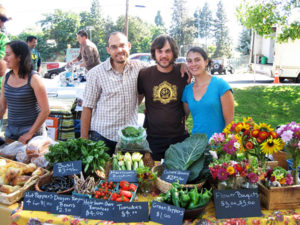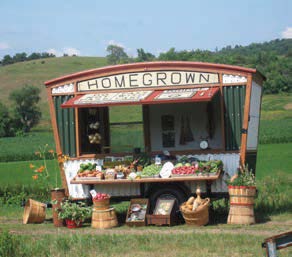Winter at Saur Farm

It’s January, and I have a terrible hankering for some fresh winter greens. The only problem is that I didn’t grow any winter crops in my puny garden this year, and the farmers’ market closed in November. In the back of my mind I remember Ben Saur, one of the owners of 10-Speed Coffee in the Hood River Heights and a local farmer, mentioning he still had carrots back in December. Maybe he still has greens? I stop by the shop to buy a cup of coffee, and ask him what he still has in the field. “Carrots, rutabaga, leeks, collards, and turnips,” Ben says while handing me my 16 oz. Guatemalan roast. We quickly negotiate a box of mixed vegetables, and I stop by the next day to retrieve my fresh bounty.
Ben Saur and his wife Anastasia operate Saur Farming along with some help from Ben’s brother, Tim. Anastasia’s main farming focus is cut flowers, and Ben focuses on vegetables. Ben’s farm is less than an acre. Some of it he doesn’t even irrigate, and he only farms part time. Regardless, he was able to maintain a beautiful stand at the Gorge Grown Farmers’ Market last season, and he sold produce to Solstice Wood Fire Café and Celilo Restaurant.
Ben is a Hood River native. Shortly aftergetting married, he and Anastasia decided to try out the city life in Portland—it wasn’t for them. “I realized how important my connection to the land and to home was, and what a special relationship that was,” Ben shared. Upon returning, Ben and his wife used that desire for a renewed connection to the land to start farming in Hood River County.
Ben says he’s always enjoyed growing things, and he is attracted to what he calls “the beauty of working with natural systems.” When I asked Ben why he decided to start farming he said, “I’ve always known I wanted to do something important, and I can’t think of anything more important than feeding people.”
Right now Ben is busy planning out his crops for this season and ordering seeds. Excitingly, he is actually still pulling crops off his field (can I get another box of greens, Ben?). He’s decided to focus on autumn and late harvest varieties like storage crops, including winter squash, onions, potatoes and root vegetables, and cold-tolerant crops, including kale, leeks and carrots. “‘Everyone grows tomatoes, zucchini and peppers. That’s awesome, but I’m thinking of focusing on something different.”
Spring at Saur Farm
It’s the first farmers’ market of the season in early May, and farmers and shoppers are shoulder to shoulder in the beautiful Hood River Middle School cafeteria. The market is generally outside, but when the weather is gray and wet the market moves indoors. I shake the raindrops off my spring jacket, and peruse the impressive farmers’ booths lining the room’s perimeter. I stop at the Saur’s to say howdy and to see what goods they’ve brought to market today.
The Saur brothers always have a beautiful booth at the Thursday Farmers’ Market, and their customer service is shining. Ben and Tim are always smiling, and always willing to chat about their vegetables with curious shoppers. At this early May market, vibrant greens,yellow squash, pesto, and herbs can be found at their table donning a bright yellow floral tablecloth. They’re even marketing their own value-added invention: squashenade—it’s more or less a squash based spread, and it’s quite delicious. Their presentation is good. It makes you want to buy their vegetables.
The shopper goes home with collard greens for the first time in his life. I’d bet money he returned the next week and the week following for more. The vegetables the Saurs grow look good and taste good because they pay attention to the soil, water, and air that help their vegetables grow.
Summer at Saur Farm
It’s a beautiful July evening at the Farmers’ Market. Behind a few puffy clouds you can see Mt. Adams off in the distance and across the Columbia River. Families, children, dogs on leashes, and even produce, are buzzing with excitement. It’s the beginning of summer harvest season, and the allure of delicious, local fruit—peaches, strawberries, raspberries, gooseberries, and blueberries—has attracted extra market shoppers. The market is packed.





One Comment
Danny
There are studies that show/prove TRUE organics have more vitamins, and trace minerals for you. The organics that are mass produced for the big box store market are really not that different from the conventional stuff. Just a bit fewer chemicals on them. True organics, grown by small farmers, and gardners are a world of difference, when done correctly. We live on a permaculture farm. Everything is returned back to the soil. Our soil is not being robbed of minerals, and nutrients. We have a THRIVING microsopic bacterial life on our farm. Even animals that die on our farm are composted, and returned to the soil. You can look at the soil of a conventional modern farm. The soil is greyish, and if you take up a handful, you will be hardpressed to find life in it. Our soil is black, and smells rich and moiste. You will have many critters you can see, and many you cannot see wiggling about in your hand. You can take anything we grow, and compare it to ANY grocery store, or mass produced organic, and even a laymen will be able to see, SMELL, and taste the difference. If you hold a grocery store tomato (organic or not) right up to your nose, you MIGHT smell the tomato. On our farm, you can walk out the door on a warm day, and be hit immediately with the strong scents of the vegtables. You can open our regrigerator, and be hit with a blast of delicious smells of all the fresh (but chilled) vegtables inside.TRUE organics are completely different from anything most people ever eat. The yokes on our chicken eggs are orange (beta carotenes). The fats in our eggs are actually GOOD for you, unlike the fats of the mass raised, grain fed chickens.I can tell you that REAL organics really are better for you.~GarnetHomesteading/Farming over 20 years